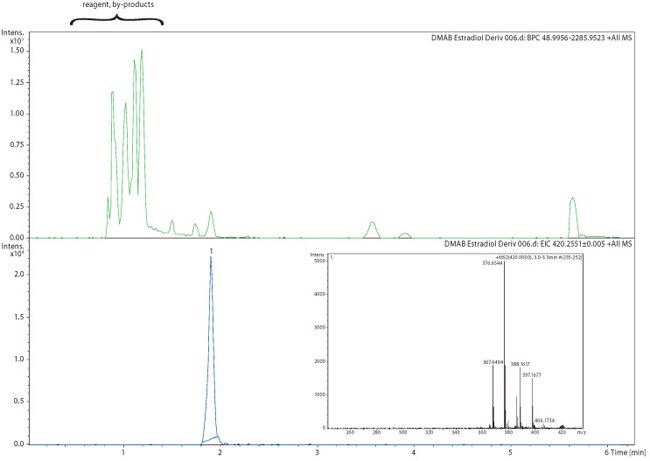Derivatization Agents for LC/MS – An Improved Detection of Estradiol with ESI-MS
Rudolf Köhling, Senior Scientist
LC/MS Applications
Analytix Volume 4, 2011, Article 4
Steroid hormones are derivatives of cholesterol and play an important role in a large variety of organisms, as they can have direct control over the gene expression. 17β-estradiol (E2) controls the growth and function of female secondary sexual characteristics. High blood concentrations inhibit the formation of further regulatory factors responsible for ovulation and pregnancy. E2 and its derivatives, e. g. ethinyl estradiol, are included in commonly used, widespread contraceptive pharmaceuticals, which is having a thus far unconsidered environmental impact; increased concentrations of estradiol and its metabolites in wastewater.1,2 Clinical and environmental laboratories alike now have a vital interest in finding the most sensitive method for the analysis of E2 and other steroid hormones, which are usually in matrices and so difficult to remove.
E2 is a very nonpolar compound and hardly detectable by ESI. Fortunately, the analyte can be extracted very efficiently with solvents like methylene chloride or acetone. In addition, this procedure reduces the negative effects of the matrix, e. g. signal suppression by alkali salts. However, only the introduction of ionizable moieties by derivatization can enhance the detection limits significantly. Dansyl chloride is the most common agent and reacts selectively and quantitatively with E2, testosterone and their derivatives.3,4 The detection is limited to APCI and APPI sources, which have some disadvantages regarding availability, dopant usage, and the lower sensitivity of the APCI source (Figure 1). The MS/MS spectra result a large number fragments and a lower sensitivity on the quantifier.
A more sensitive and versatile derivatization agent for ESI sources is 4-(Dimethylamino) benzoyl chloride (67954, DMABC). The reagent can be dissolved in acetone and applied on the dried residue of the sample extract. An adjustment of the pH is not necessary; only an anhydrous reaction medium is needed. The high purity of DMABC guarantees good solubility, and a very selective, quantitative reaction at a moderate temperature between 55–60 °C (5 min.). The reagent and possible by-products can be separated from the analytes using a standard reversed phase HPLC column, and can be detected down to very low concentrations (Figure 3).

Figure 1. Separation and detection of 55 pg E2 as dansyl derivative (EIC, peak 1). Only a short pre-column (Supelco Ascentis Express C18, 2.7 µM, 2.1 x 5mm, 53501-U) is necessary to separate the analyte from excessive reagent and by-products (BPC, magenta). The inset shows the MS/MS spectrum of [M+H]+=506.235 Da (APCI+).

Figure 2.Derivatization reaction of E2 and DMABC. At a high E2 level of 5 ppm, only 0.2 % (rel. area fraction) of DAMBC reacts with the second hydroxyl moiety (2:1 adduct). At 5 ppb E2 concentration, the 2:1 adduct is below the detection limit.

Figure 3. Injection of 5 pg DMAB-E2 derivative and separation on a UHPLC system using a 2.1 x 50 mm Supelco® Ascentis® Express C18 column (2.7 µM, 2.1 x 50 mm, 53822-U). The mobile phase conditions are water/0.01% formic acid/acetonitrile (30/70) at a flow rate of 0.4 mL/min. The MS/MS spectrum (inset) shows only four major peaks, which is ideal for quantification and identification using a triple quadrupole mass spectrometer.
References
Para continuar lendo, faça login ou crie uma conta.
Ainda não tem uma conta?